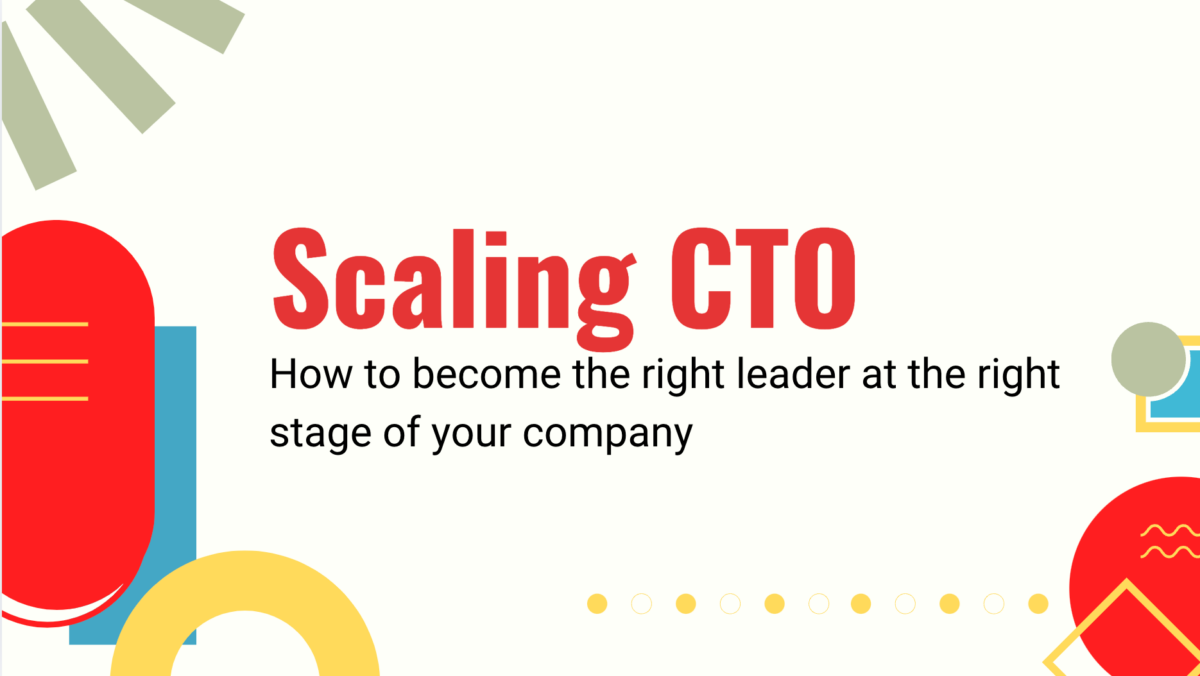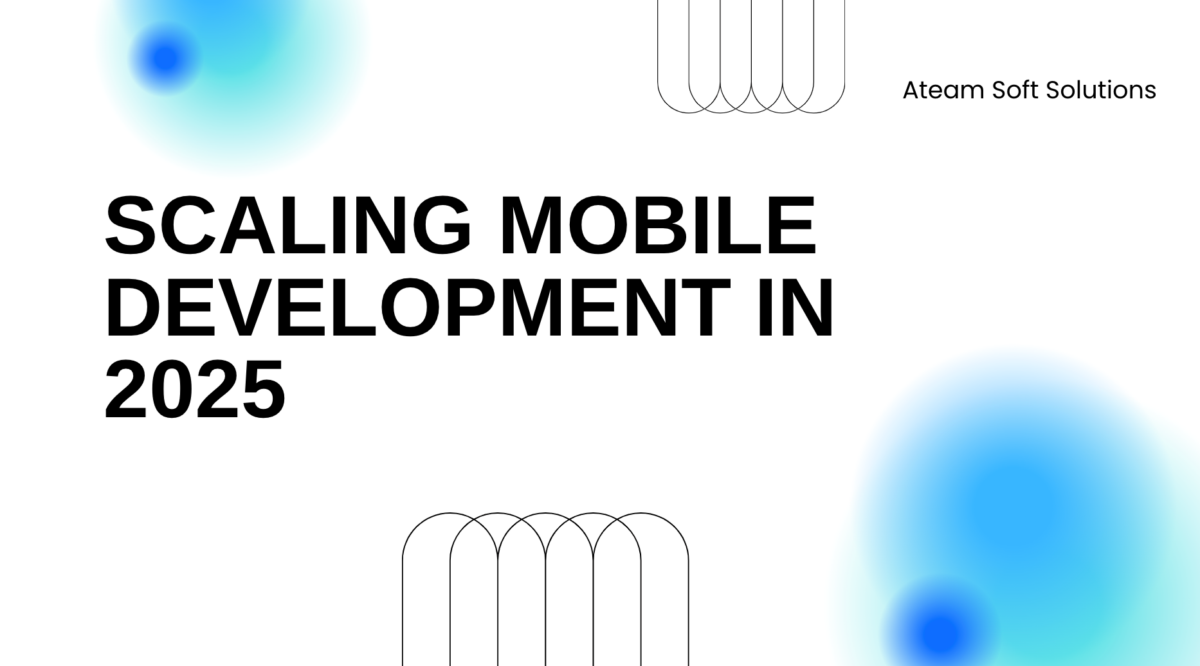This website uses cookies so that we can provide you with the best user experience possible. Cookie information is stored in your browser and performs functions such as recognising you when you return to our website and helping our team to understand which sections of the website you find most interesting and useful.
How Much Does It Cost to Develop A Mobile Application in 2024?
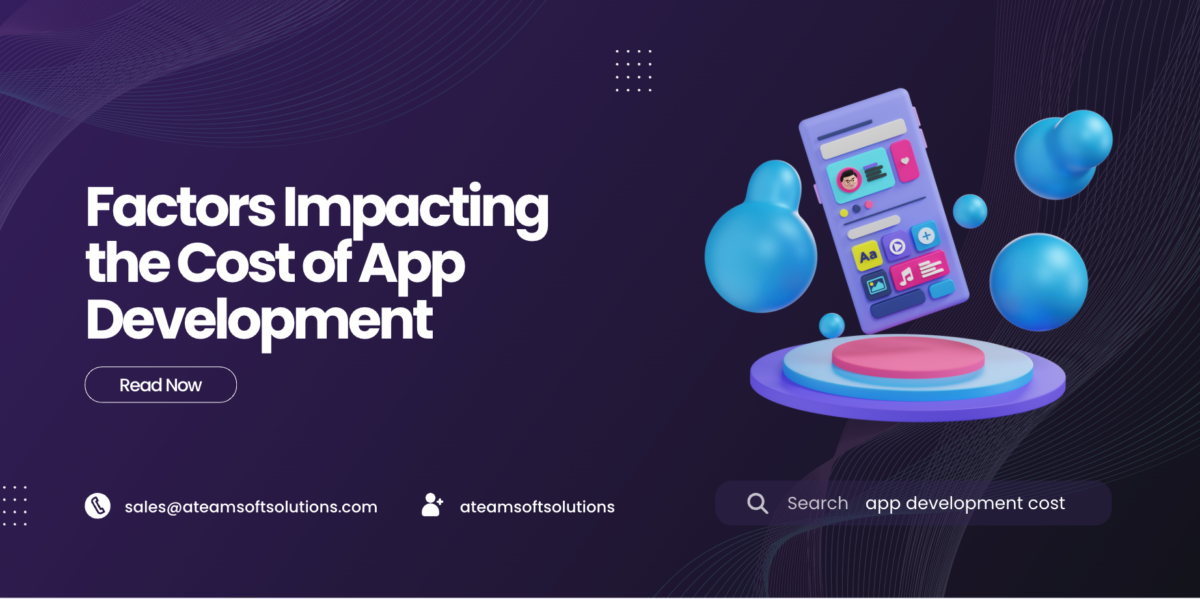
Understanding the Cost of App Development
Since the demand for digital tools is rising with business operations and interactions, the cost of developing an app becomes increasingly critical. Here is a guide that discusses the financial aspects of developing a mobile app by evaluating the impact of factors like design complexity, feature integration, and the chosen technology on the end cost. No matter whether you are a starter with an idea of introducing a disruptive app or an enterprise with a goal to extend its digital services, it is the correct estimation of the costs of development that will help you to fit your project into your strategic business goals and make the investment profitable. Come with us and discover the key factors that will determine the fees of app development in the year 2024. You will be knowledgeable and make the right, informed choices. Here are the top factors and how they decided the app development cost.
10 Factors Impacting the Cost of App Development
#1 Type of Apps
The app development environment is becoming more and more complex. Therefore, the appropriate understanding of the different types of applications and their corresponding costs is inevitable. As a mobile app development agency we lead, we develop software that has various levels of complexity, from basic utility apps to complex systems.
Simple Apps: Fast Application with Little Back End
The simple applications have highly simplified functionalities and rarely have complex tasks that require numerous backend services. They may often be created quickly and at a lower cost, which can be a potential option for small businesses wanting to have a digital presence and functionality.
1. Basic Informational Apps: These apps work as digital brochures or company portfolios, consisting of static information, which all too most of the time, does not alter. They are simply constructed, which is very cheap, so they are a cost-effective solution for firms that need a simple digital profile. Estimated app dev cost: From $5,000 to $10,000.
2. Event Apps: Customized to serve particular occasions, these apps comprise schedules, connection details, maps, localization, and support. They may be slightly more complicated because of the dynamic information and integration, for example: notifications and calendars. Cost of app building: $10K to $20K.
Utility Apps: Besides performing one functionality such as a calculator or flashlight, these apps are straight-up in their design and operation. These factors keep the development costs down. How much to develop an app like this: $5000 to $15000.
3. Basic Content Apps: These can be used by content creators who want to send/distribute text, video, or audio content e.g. news feeds or blogs. The apps gather and bring together posts that were initially published on existing sources. The average cost to develop an app of this nature: is $10,000 and even up to $25,000.
4. Reminder Apps: The functions of these mini apps are based on setting up notifications that are triggered by either time or user input. With these, users can manage their tasks and schedules in a timely manner. App development cost: Amounting to $8,000 to $20,000.
Moderately Complex Apps with Increased features and integration
1. E-commerce Apps: Enable online shopping, user profile administration, and product catalog management. Such applications must have secure payment integrations and a solid user interface to guarantee pleasant shopping. Mobile app development cost: $50000 to $150000.
2. Social Media Apps: Offer networking, content sharing, and community participation tools. Development must be scalable enough to serve huge numbers of users, and also be able to process large amounts of data. How much can a social media app development cost? Around $60,000 to $150,000.
3. Educational Apps: Employ the next level of interactivity with multimedia content, quizzes, and learning modules. They might as well include following the progress and linking with the educational resources. Custom app development costs: $50K to $100K.
4. Fitness Tracker Apps: Utilize sensors and data to record user activities like steps, heart rate, and GPS for proceeding with the running routes. These apps work with real-time data processing like other devices connected with them. App development cost: $40,000 – $100,000.
5. Travel Apps: Offer bookings, personal itineraries, and user reviews. High-level integration with travel service providers as well as strong backend support that allows for user information and preferences processing is a necessity. The cost to develop an app of this complexity: is $60,000 – $120,000.
Complex Apps with Extensive Coding and Deep Backend Processing Logic
1. Augmented Reality Apps: Provide an immersive experience by mixing digital items with reality. AR apps are the latest trend and they need very good graphics and processing power. What price is involved in making an app with AR capabilities? Starting at $100,000.
2. Comprehensive Gaming Apps: Incorporate advanced graphics, real-time multiplayer options, and physical engines. They are the apps with the highest development costs due to their intricacy and the need for constant upgrades. App development cost: $100,000 to $500,000.
3. Advanced Business Apps: Primarily considered by enterprises for CRM, ERP, and automated marketing purposes. These apps run all across the business operations and they require high levels of security and customization. How much does an app for business development cost? $150,000 to $300,000.
4. Healthcare Apps: Need to be compliant with regulations like HIPAA as well as providing features for patient management appointment scheduling as well as medical data handling in a confidential way. Cost to develop an app in healthcare: Beginning at $100,000.
5. Banking Apps: Demand high-level security, excellent architecture, and smooth integration with the bank system. They provide support to the transactions, account management as well as other financial services. How much does it cost to create an app for banking purposes? App development cost: $8,000 to $20,000.
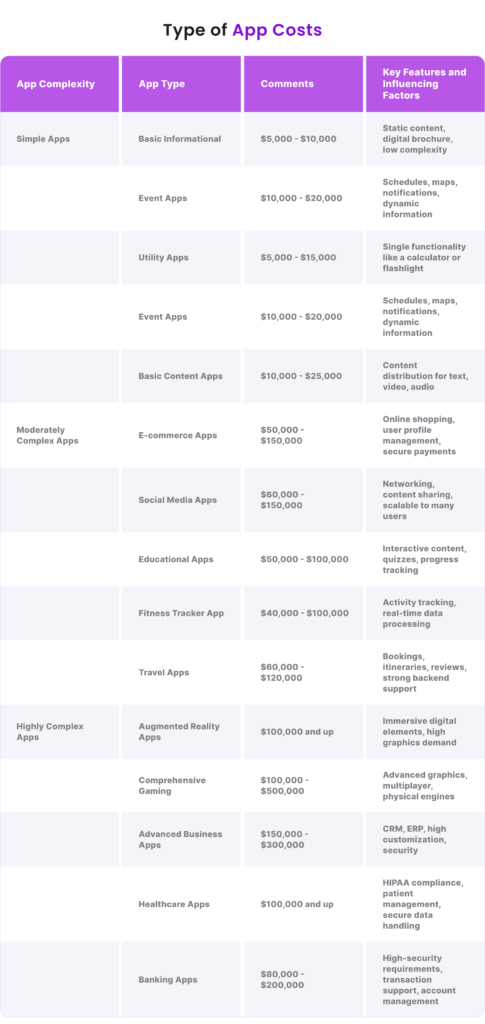
#2 Features and functionalities of the Application
More features = More cost. Here is what features cost on average.
-
User Registration and Profile Management:
The main feature of custom app development is user registration and profile management. The cost to develop an app with basic user registration typically varies between $2000 and $5000. This feature enables them to design and manage a profile within the app, which is significant for providing a personalized experience and keeping user data. If you want to increase user engagement and ease the process with social media platforms, you will have to spend around $10,000. The integration makes it possible for users to sign up or log in via Facebook or Google networks. This simplifies the process and increases accessibility.
-
Navigation and Search Functions:
The apps with dynamic user interactions and content discovery should have navigation and search functionalities in place. These are the key issues from the UX/UI design perspective and generally cost between $3000 to $10000 depending on the complexity of implementation. Proper navigation makes the app easier to use and a good search function helps users explore the content of the app which is very useful for e-commerce and media apps that have large databases.
-
Basic Offline Capabilities:
Adding offline capabilities to the app in order to make sure that the app will continue to function with limited features in the event that the users are not connected to the internet can greatly improve the app’s user experience. This aspect is essential for utility and media apps that are designed to work even when internet connectivity is not available. Extra $5,000 to $10,000 are to be added to the cost of app building for having basic offline features. This includes data caching and retrieval mechanisms that are so advanced that the app functions or serves content even without a live network connection.
-
Enhanced Capabilities and Their Corresponding Development Costs
1. Third-Party API Integrations:
Beyond that, the integration of third-party APIs like payment gateways (Stripe, PayPal), social media (Facebook, Twitter APIs), or cloud services (AWS, Google Cloud) is a significant feature addition but equally increases how much it costs to create an app. Costs can range from $10,000 to $25,000 depending on the API’s complexity and the integration level required.
2. Real-Time Features:
By integrating real-time features such as chatting, live updates, or streaming into the app, the cost of developing an app can be raised drastically. Real-time data exchange would require solid backend services that can conserve synchronous communication between the app and the server, which will be advanced from $10,000 to $50,000. Such options are of primary importance for applications whose goal is immediate communication or updates like chat apps or stock trading platforms where time is a factor.
3. Advanced-Data Encryption and Security:
Apps that manage such critical information as financial data, personal identification details, or health records require data encryption with the latest technology and highly secured protocols. When designing an app with advanced security features, at least an extra $10,000 to $30,000 will be added to the budget for development. Making an investment in this means that the app is in compliance with all legal requirements such as GDPR and HIPAA, therefore, user data is always secure from theft and breach.
4. Custom Animations and High-Fidelity Designs:
App designers want users to keep using their app so they integrate custom animations and high-quality graphics that look very realistic. These components take a lot of commitment in terms of time and expertise, which is a primary concern as far as app development costs are concerned. According to the level of complexity and the animations’ high end, the developers may include these features, costing $15,000 to $50,000. These types of financial investments are necessary for branding and can make a huge impact by giving users a beautiful and interactive user interface.
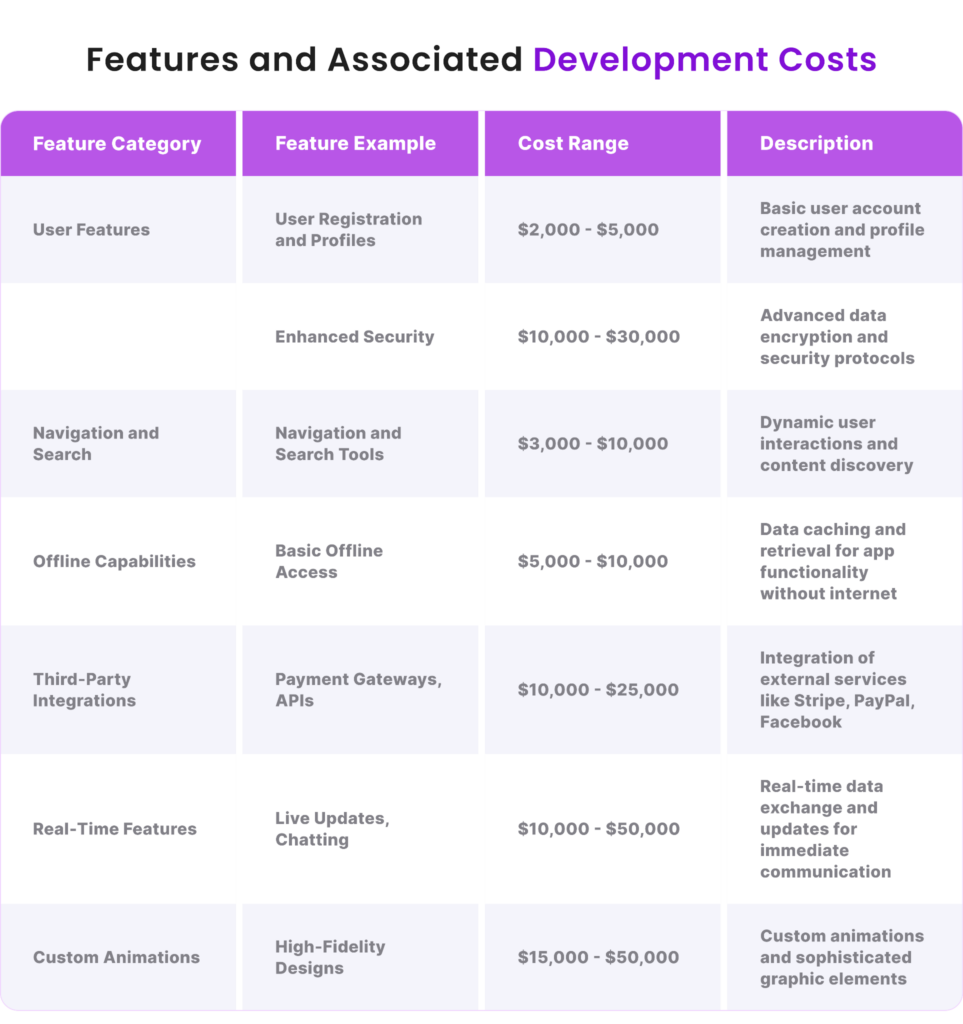
#3 UI/UX app development cost
The significance of the user interface (UI) and user experience (UX) within the mobile app development domain can be surely discounted. In the 2024 venture, the demand for user-friendly, interactive, and aesthetically appealing apps is at the highest point; this demand is more than ever before. This is the reason why they are of prime importance not only for the user’s feelings but also for the commercial success of the app. This part will discuss how UI/UX impacts app development expenses based on the figures and the benchmarks in the industry of the relevant published data.
1. Basic UI/UX Design: For example, interface design expenses for apps with weak user interaction or lower complexity begin at approximately $5,000. Only the fundamental wireframes, standard UI elements, and user flow diagrams without special graphics or interactions should be presented as an initial step.
2. Intermediate to Advanced Design: With the growth of the app design, there will be a need for more complex UI/UX. We create prototypes on which we work on detailed wireframes, high-fidelity mockups, dynamic interactions, and custom graphics. These designs could cost from $10,000 up to $25,000 or even beyond depending on the depth of the designs and the number of revisions that may be required.
3. Custom and High-End Design: The design stage can become very expensive in cases where custom-made or luxury design features are essential, or there are specific target users who are in a high-end clientele group. These types of apps are usually part of big enterprise apps or apps where the interface fulfills a vital function, e.g., in games or apps related to the multimedia content industry.
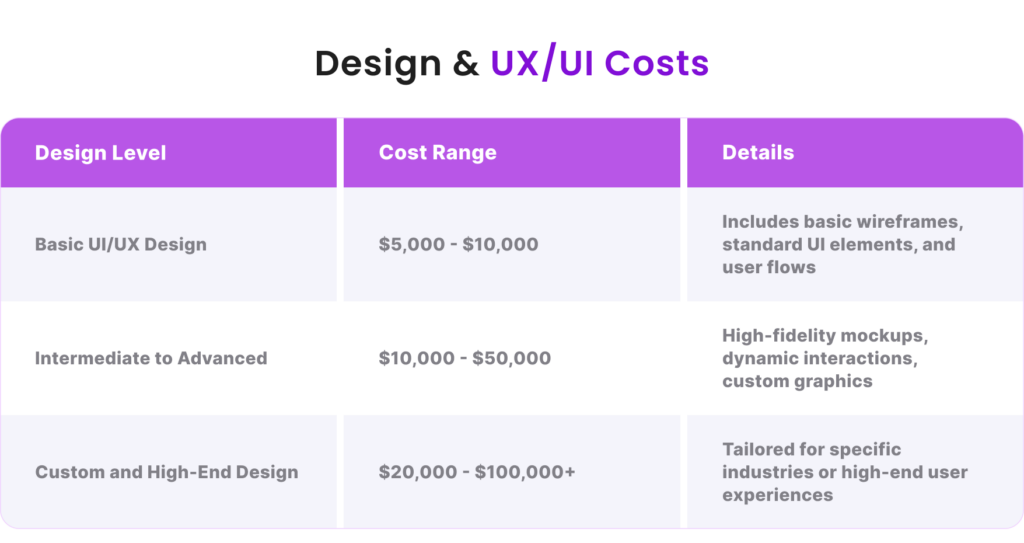
Factors that impact UI/UX Cost:
1. Complexity of User Interaction: Apps like, i.e., tools with complex interactions like collaborative tools or advanced data visualization, are more sophisticated which necessitates a more elaborate design process that in turn increases costs.
2. Custom Graphic and Animation Requirements: Bespoke graphics, animations, and transitions that could potentially take user engagement to a whole new level place a heavy burden on the costs. Such as TikTok or an advanced gaming app, they want more complex animations and video processing which cost a lot to design and present.
3. Number of Platforms and Devices: Developing an app that will ensure the same experience in a multi-platform environment (iOS, Android) and a multi-device environment (smartphones, tablets) will require the app developer to spend more time and money on the UI/UX design stage.
4. User Research and Testing: The use of extensive user research, including surveys, focus groups, and user tests, is the basis for developing a user-centered design. This phase can come with an additional $5,000 to $15,000 to the development budget, but it is crucial to establish that the app is targeting the very needs of its users.
ROI on Investment in UI/UX Design:
1. Enhanced User Retention: Apps with excellent UI/UX have improved retention. A well-crafted app may minimize user churn up to 5 times, and so directly to higher revenue.
2. Increased User Engagement: The correlation between engaging a user and effective UI/UX design is an undisputed fact. Instagram and Snapchat apps and their creative developers have gone ahead to design user-friendly interfaces that result in longer-lasting and more frequent interactions.
3. Competitive Edge: It is a competitive market and a well-designed app can get the attention of the users and the number of users increases, thus, market share and return on investment increase.
Use Case showing the Effects of UI/UX on app development Costs<
Airbnb: Another example is the Airbnb app which redesigned the whole app interface with an emphasis on enhancing usability and visual design, which eventually contributed to a 30% increase in bookings post-redesign, justifying a huge initial design cost which was the most expensive part.
#4 Customization and Branding cost
The app should be customized and branded to make it fit for the business and deliver an exceptional user experience by reflecting the company’s identity.
1. Basic Customization
- Icon and Logo Design: Costs will vary from $500 and $2,000. The initial tier is creating an eye-catching visual identity (branding) that can be known on different channels.
- Basic Color Scheme and Typography: On average, that’s between $500 and $1,500. These basics establish the framework to which a user interacts.
2. Moderate Customization
- Custom Illustrations and Graphics: Priced at between $2,000 and $5,000, these elements not only give an appealing look but also add to user involvement.
- Branded UI Elements: Besides buttons and menus, charges fluctuate from $3,000 to $8,000 USD maintaining the brand’s industry image of the app.
- Branded Animations and Transitions: These may be priced from $4,000 to $10,000 and will raise the complexity and interactivity level of the game.
3. Extensive Customization
Fully Custom UI/UX Design: This holistic approach will be priced at $8,000- $20,000 according to the designs, aiming at offering a different user experience.
Branded 3D Assets and Interactive Elements: Prices span from $10,000 to $25,000 which is an ideal range of costs for applications requiring high engagement levels.
Comprehensive Branding Package: These packages will involve logos, fonts, color palettes, and others within this range of $5,000 – $15,000.
4. Enterprise-Level Customization
Bespoke Design System Development: The extended service that costs between $15,000 and $50,000+ is necessary for solutions that are meant for large enterprise applications.
Branded AR/VR Experiences: First of all, the fees range between $20,000 to a hundred thousand.
Ongoing Design Maintenance and Updates: The budget for keeping the app’s design up-to-date and effective is usually $2,000 to $10,000 per month.
Factors Influencing Customization Costs
The complexity of Design Elements: A higher level of complexity, in turn, raises the time and expertise needed, and that, of course, leads to an increase in the cost.
Designer/Agency Hourly Rates: The hourly rates may differ from $50 to $250 attributable to the designer’s creative experience and ability to deliver excellent work.
Scope and Features of the App: The larger the scale, the higher the change or customization level.
Targeted Platforms and Devices: In this regard, developing the interfaces for several platforms or devices can increase the expenses that are spent on adapting to the various alterations that are needed.
#5 Backend Infrastructure and App Administration Cost
The foundation of a robust infrastructure is crucial for the app to perform as intended, as well as to ensure scalability. Prices can vary widely depending on the magnitude of complexity and the sort of technologies being utilized.
- Database Management: Established development and the operation of a safe and scalable database system may range from $20,000 to more with additional complications.
- Server-Side Logic: Development costs of building efficient backend logic that processes user information and integrates with other systems can amount to between $50,000 and $200,000.
- API Integration: Integrating third-party APIs for more complex functions can cost around $1,000 per integration and it might increase based on how difficult the API is to integrate and the level of customization required.
#6 App Maintenance and Updates Cost
Follow-up maintenance and updates for the app must be done constantly in order for it to remain relevant and valuable to the users in the long run.
- Annual Maintenance Costs: These expenses usually constitute around 15 -20% from the beginning of the development of the app. The cost of the routine maintenance for the complex app which is built at $200,000, is going to be between $30,000 and $40,000.
- Security Updates and Bug Fixes: Timely patching after introducing system security improvements is a must, while the overall co
#7 App Development Methodology
The choice of development methodology can impact project timeline and budget and also it affects its flexibility and the ability to respond to user feedback.
Agile Methodology:
- Characteristics: Agile is flexible with iterative development of the whole process including the development and testing phase. This way designers can recalibrate frequently and make the necessary adjustments when the market is continuously evolving.
- Cost Implication: Although Agile is initially more expensive due to the iterative nature of its product development process, it often leads to a better product solution that responds to the user needs more directly, and that potentially results in fewer costly post-launch modifications.
- Time Efficiency: Agile in this regard offers a speed of releases to the market through its sprint cycles which can lead to a faster ROI by allowing businesses to market the product quicker.
Waterfall Methodology:
- Characteristics: This model operates in a linear and sequential way such that the phases are not blended. At the end of a phase, development goes on to the next without returning back to the previous one.
- Cost Implication: Waterfall is cheaper when starting up as it follows a sequence, but re-doing the previous parts when changes are made later is very expensive.
- Predictability: Have a more predictable schedule and budget therefore suitable for projects with very limited and fixed requirements.
Hybrid Methodology:
- Characteristics: Both Agile and Waterfall features are combined and agile methodology is used to the extent possible after assessing the project.
- Flexibility and Control: Flexibility can be provided when it is needed along with a structured policy that will be beneficial for the complex projects involving different players.
Project Examples
- The app based on agile methodology would catch up more promptly with the varying compliance rules than the one developed on Waterfall would, and the consequence could be that the company would be saved from hefty updates and possible legal complications.
- A content delivery platform built with a Hybrid approach ensures efficient management of its predictable hardware transformation necessities (Waterfall) in addition to user-oriented content outputs (Agile).
Table 4: Development Methodologies and Their Impact
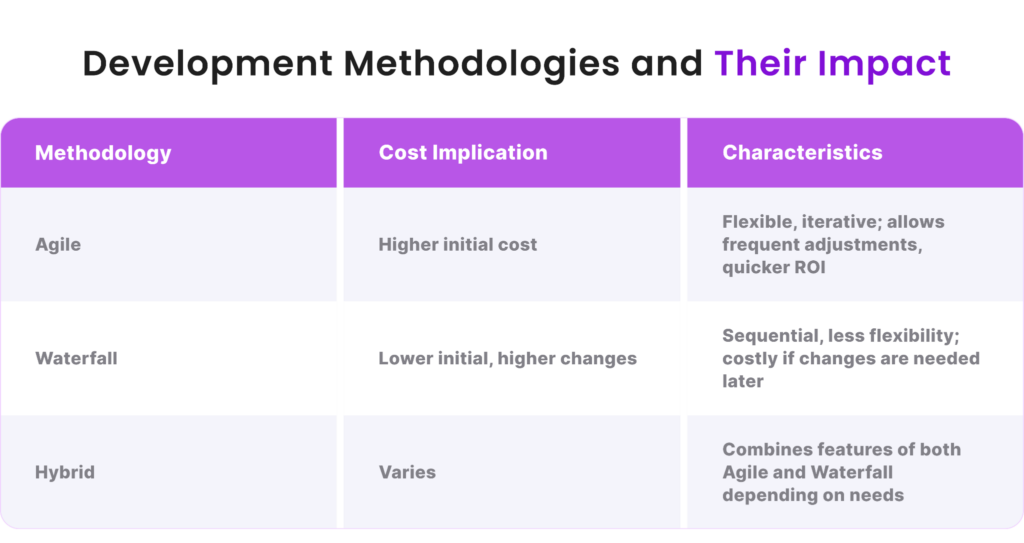
#8 Testing and Quality Assurance Cost
Testing and QA are indispensable in app development, providing the framework for building a stable, secure, and easy-to-use application. undefined
Importance of Testing: QA is not only about error finding. It is about making sure the app can perform its functionalities and meet the user’s expectations using all devices and platforms. Such a process covers performance testing, usability testing, security testing, and compatibility testing.
Cost Factors in QA:
- Scope of Testing: Thoroughly testing the app across all domains, including uncommon user scenarios, can be an expensive effort but a must-have for quality applications.
- Tools and Technologies: An increase in the upfront expenses caused by advanced testing tools and technologies, for example, automated testing suites, could potentially decrease the long-term expenditures on manual testing.
- Human Resources: Implementation of a more complex app might require hiring a bigger QA team, enhancing the overall labor cost.
- Percentage of Development Cost: Generally, the testing and QA may comprise up to 10-15% of the total app development cost. For an app of $200,000 to develop, you could estimate around $20,000 to $30,000 to be spent on testing and QA.
- Ongoing Testing: The post-release testing also plays a critical role as the new upgrades and user environments may bring out new issues. Splitting a segment of the budget for continued QA guarantees that the app stays high-standard from the start to the end.
#9 Team Contributions to Mobile App Development Cost
The engineering of a mobile application is not only a coding job, additionally, it is a collective work of professionals from different specializations. Each team member is crucial to the success of the activity and their knowledge must be taken into account when drafting the overall budget.
-
Core Team Members
1. Project Manager: A vital factor for monitoring deliverables and keeping up with deadlines. They act as the communication link among all team members to make the collaboration effective. Hourly rates vary from $60 to $120, thus controlling project management becomes a crucial element.
2. UI/UX Designer: The app is responsible for design both aesthetic and functional. Their work is a direct measure of user engagement and satisfaction with an hourly range between $30 and $70.
3. Mobile Developer: UI/UX designers have their ideas translated into HTML, CSS, or JavaScript by the front-end developers. Concerning their skills for either iOS or Android, the rates are $35 to $120 per hour.
4. Back-end Developer: Emphasizes server-side development, dealing with the interactions between the app, its database, and the server, which are a vital part of app functionality and security. Experts charge about $35 to $120 for their hourly services.
-
Quality Assurance
App developers not only code but also control the quality of code and design by thoroughly testing the app against the project requirements prior to its launch. This role takes care of minimizing bugs and ensuring the user’s experience is as smooth as possible. Their involvement may be $30 to $70 per hour.
#10 Marketing and Deployment Cost
Successfully launching an app requires a strategic marketing and deployment component, which is essential for ensuring that the app reaches its target audience and accomplishes downloads and usage purposes.
- Pre-Launch Marketing: The plan includes teasing, a press release, and a preview of the app to create hype. Pre-launch marketing gathers interest and makes the users download the app immediately when it is launched.
- Launch Campaigns: The marketing efforts should be supported by a full-blown campaign including social media ads, influencer partnerships, email marketing, and any other marketing activity. Expenses for this purpose may be anywhere from $5,000 to $20,000, depending on the size of the campaign, and the channels used.
- App Store Optimization (ASO): ASO is necessary for achieving a good placement in app store search results. This involves choosing the title, keywords, description, and screenshots wisely. Although some tasks related to ASO can be done in-house, the cost of hiring a professional ASO agency can range from $1000 to $5000.
- Post-Launch Marketing: Once the launch is done, the target becomes keeping the memory alive and fresh through updates, engagement of the community, and constant marketing activities. It is very significant in order to keep the existing users and attract new ones, and monthly expenses depend on the activities performed.
- Deployment Costs: The deployment of the app is not just a simple submission to different app stores but also setting up servers, databases, and technical aspects to ensure that a smooth launch procedure is in place. Deployment of the technical components can cost from $2,000 to $10,000 depending on the app complexity and infrastructure needed.
Cost Breakdown by Stages in Mobile App Development
Having complete knowledge of the development phases and the costs involved is extremely important when a developer wants to start an app. The budgeting process for app development can be broadly broken down into several key stages: the Discovery/Strategy Phase, the Design Phase, and the Development Phase. Every phase entails its own type of costs, which depend on many factors such as the project’s complexity, the number of necessary functionalities, and the design creativeness. The various phases are discussed next with the aim of giving a detailed account of the accruing costs and factors that affect the costs.
1. Discovery/Strategy Phase:
The first phase of app development, the Discovery/Strategy Phase, is highly important for creating a strong basis for the project.
- Market Research: The key elements to consider are the market structure, the rivals, and the customer’s requirements. The step is designed to enable the app’s features to be in line with the demands of the market and the expectations of the users.
- Cost Range: The cost of this stage generally varies between $1,200 and $11,000. The depth of the research required is one of the primary factors affecting cost.
- Outcomes: The outcomes of this stage are a market study report, project plan, and features list which altogether drive the subsequent stages of app development.
2. Design Phase:
Now with a clear strategic picture of the matter, the Design Phase will concentrate on crafting the user interface and user experience that is aligned to the findings of the initial research.
- UI/UX Design: This entails the production of wireframes, mockups, and prototypes that facilitate the visualization and interactivity of the app. This stage is the most important one for the app’s ease of use and functionality.
- Cost Range: The design phase can range from $3,500 to $30,000 based on the app’s complexity. A basic application with a single screen and a clear design will demand less than a complex one with a lot of screens and unique UX components.
- Design Tools and Expertise: The choice of high-level design tools as well as the hiring of skilled designers can also play a big role in the cost. Whether it comes to software like Sketch, Adobe XD, or Figma as well as the specialized skills for animation or advanced UX, this can increase the cost.
3. Development Phase:
This is the first stage of development which is the building phase of the application through coding and programming. This stage is paramount as it translates the design specifications and prototypes into working software.
- Integration of Functionalities: This entails writing APIs, setting up databases, and coding the outlined functionalities in the discovery phase.
- Cost Factors: The implementation phase is usually the most costly part of an application. This phase of app development could cost you on an average between $4,000 to $80,000 and more based on complexity.
- Feature Complexity: The more advanced and sophisticated features, for example, real-time data synchronization, complex database operations, or advanced security measures, require more time and expertise from the developer, so the project costs increase.
- Technology Stack: The technology selection, native development for iOS and Android, or cross-platform solutions like React Native or Flutter, come with associated costs. A native development might turn out to be more costly because it requires the creation of various codebases for different platforms.
- Development Team: The position of the development team and its composition bring about the costs. Regional teams located in North America or Western Europe charge more than those in Eastern Europe or Asia. The team’s experience and record of performance also contribute to the cost assessment.
4. Testing and Deployment
Testing and Deployment is a crucial stage in the development of the app. The last product will be very efficient and user-friendly, without any critical errors. undefined
- Types of Testing: Includes Functional Testing, Usability Testing, Performance Testing, Security Testing, and Device and Platform Testing.
- Deployment Readiness: Involves App Store Optimization (ASO) and Beta Testing to ensure the app is ready for public release.
- Cost Implications: The price for this phase usually lies in the range from $5,000 to $10,000 depending on the complexity of the app development and the volume of testing. This estimate also covers the costs of the rigid testing cycles and revisions before shipping.
5. Maintenance and Updates
Posting an app is not the end of work. Continuous processes of maintenance and updates are applied, to ensure that the app stays relevant, secure, and functional.
- Importance of Maintenance: Includes User Feedback, New Features, and Security enhancements.
- Types of Maintenance: Corrective, Adaptive, Perfective, and Preventive Maintenance.
- Cost of Maintenance: The average annual maintenance cost is around 15-20% of the first app development budget.
Initially, the app is priced at $100,000, and you should budget in the region of $15,000 to $20,000 for maintenance costs on an annual basis. This budget covers everything ranging from debugging to adapting to technical changes and adding new features that take user engagement and app performance to the next level.
8 Tips to Reduce App Development Cost
A primary concern for companies is the question of how to minimize the development cost of apps without compromising on quality, which is necessary for getting the best results from digital investments. Here are seven actionable and insightful tips to help you streamline the app development process and effectively manage your budget:
1. Doing First Things First with Minimum Viable Product (MVP) Strategy
One of the most appropriate methods of low-cost app development is to use the MVP (Minimum Viable Product) approach. This implies defining and choosing the fundamental components that make up your app and responding to the key requirements of its users so that you can release the main functions that they need. By focusing on an essential feature set, you can severely reduce the initial development cost and duration. In addition to facilitating a fast-to-market entry, an MVP gives you an opportunity to test the application with real users whether it is viable or not. This feedback, in turn, can be used for continuous improvement as the developers can refine the features or add new ones based on user demand or actual app performance, instead of making changes based on assumptions. With this precise approach, you reduce waste and optimize your investment by only investing in functions that provide the most value to the user.
2. Outsourcing to Low-Cost Locations
Having your app developed from areas with lower labor costs by outsourcing could save you a large amount of money. India and other countries are the best places where development services are provided at competitive rates, but without compromising on the quality of work, thanks to the large pool of skilled developers. Nevertheless, the most important thing is to select a reliable outsourcing partner. Choose a reputable and reliable provider that has proven success by looking at the reviews. Efficient communication is a must, so take into account possible language barriers and time zone fluctuations that may hinder the joint work. Partnering with companies that are experts in the current trends of the user interface can lead to less expensive options. For instance, the partnership of Agile development or serverless architecture specialists brings a level of expertise that can sharply reduce the time and cost linked with the adoption of these technologies. Furthermore, if outsourcing to the areas not only with a low cost but also a strong emphasis on the latest technology is done, you can maintain a competitive advantage while keeping the budget under control.
3. Use Feature Flags for the Successive Release of New Functionalities
Employing feature flags is a technical measure that enables you to roll out new features without performing a code deployment. With this, you can roll out new functions to particular user groups and then roll them out only to a wider user base afterward. The feature toggling mechanism enables developers to perform deployments without having to go through multiple deployments, which leads to substantial savings in development and rollback costs. It also takes risks out of the equation by isolating what is stable from the feature performance issues, making sure that the impression on the user experience is as little as possible.
4. Utilize Serverless Architecture
A serverless platform can be a budget-friendly alternative to traditional server-oriented solutions. With serverless architecture, you are able to manage your backend services in a pay-as-you-go manner where you only pay for code execution when it executes. This model does away with server maintenance and capacity planning costs, thus, leaving no need for continuous server management and operation. AWS Lambda, Azure Functions, and Google Cloud Functions are among the technologies that offer highly effective platforms to implement the serverless architecture in a very efficient manner.
5. Adopt Advanced Caching Technologies
The main feature of caching is to reduce the load on the server and make the app quicker. Through the adoption of advanced caching techniques including data grid or distributed caching, you would be able to decrease the database load and minimize the infrastructure costs, which is directly proportional to the latency. Techniques such as edge caching can also be used to store the content close to users; thereby, decreasing the load times and improving the user experience, while minimizing the data requirements.
6. Improve the Data Exchange Formats
Using the most appropriate data exchange format for your app, which could be JSON or XML, can help you greatly in reducing the amount of data sent from servers to clients. Not only does this accelerate data handling, but also decreases expenses associated with data transfer and storage. Making use of compressed file formats and data compression techniques not only decreases the payload size and, thus, the bandwidth consumption but also speeds up the processing time.
7. Incorporate CI/CD Pipelines Throughout
CI/CD pipelines bring automation for tasks in app development such as builds, tests, and deployments which lead to faster development cycles and chances of human error. Through this automation, you always integrate code changes quickly and validate them, which leads to diminishing the necessity of extensive manual testing and debugging. Automation enables quicker and more efficient development by reducing the amount of time needed to release new features or fixes.
8. Leverage Containerization
The technology of containers, such as Docker and Kubernetes, provides a handy way to do the building, deployment, and administration of applications. Containers encapsulate an app’s dependencies just like carrots envelop them, therefore, making it easier to move them across environments and minimizing compatibility issues. It also brings the development process together as it is simple and one cannot blame work as my machine problem now as it is feasible for everyone to set up with less waste and speed up the deployment cycles.
3 Factors You Should Consider to Determine App Development Cost
1. Offshore vs Nearshore:
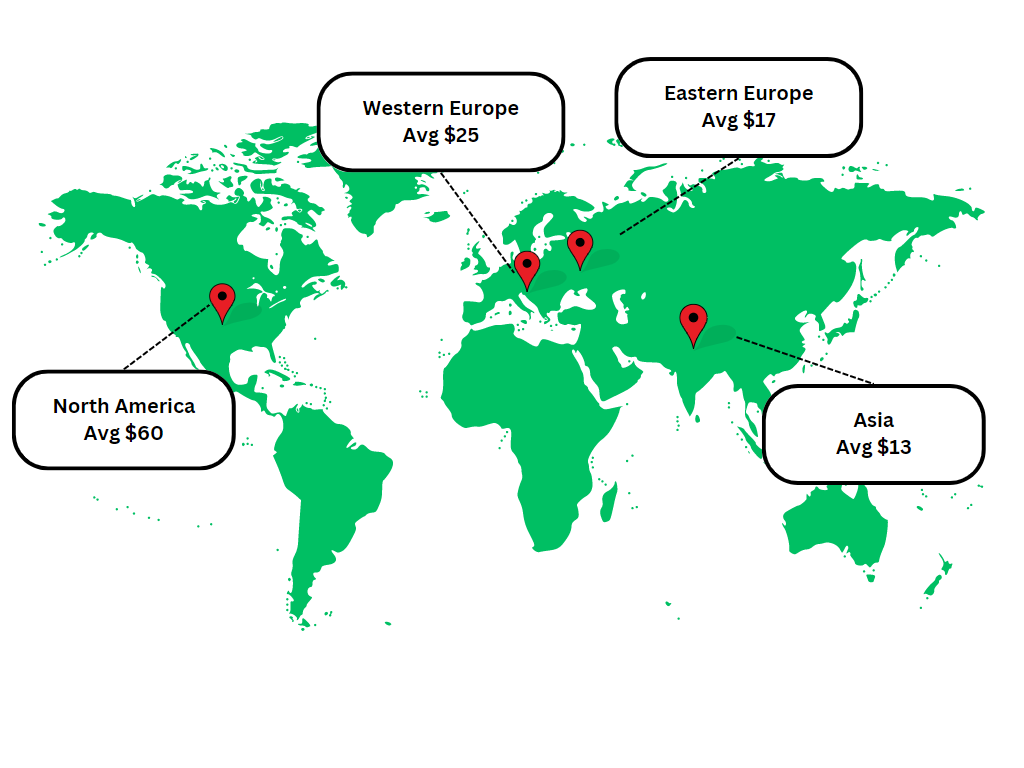
Looking at the effects of offshoring versus nearshoring on app development costs, you need to bear in mind the labor costs, economic conditions, and the quality of the technical workforce. Employing your information, let’s investigate the drivers that make offshoring the better option than nearshoring. Specifically, we shall focus on what makes the Indian and Mexican options cheaper and perhaps higher quality.
Economic and Labor Price Variety:
One of the main driving factors for offshoring to India is the significant cost advantage of it which is mainly because of the low labor cost that is characteristic of these regions. This is due to not only the economic dimension, but also living costs, wage rates, and local market conditions.
The hourly rate for mobile app development in India would be between $30 and $35 which is much lower than Mexico’s rate of $40 to $50. Once this difference is compared to the rates in the USA ($100 to $150) and the UK ($70 to $85), it becomes much more evident. These discrepancies are the results of the differences in the economic conditions of these countries. India has a lower cost of living, so the operational and labour costs can be low, but the quality of the end result remains the same.
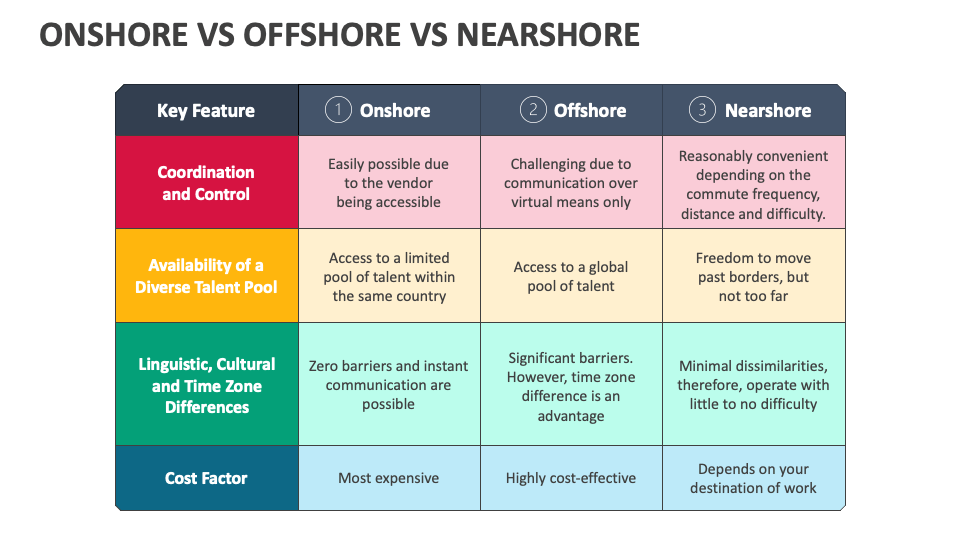
Quality of Technical Workforce:
The Indian emphasis on STEM education has built up a large number of IT professionals who are not only experts in the latest tech and aware of the English language but also do great work at lower prices, making it a great location for the development of high-quality apps.
- Workforce Quality:
Though the price of Indian developers may be lower, the quality of their output is appreciated across the globe. Indian developers are usually well acquainted with up-to-date technologies and methodologies used in the development of modern applications, including Agile and DevOps.
- Scalability and Flexibility:
The offshoring solution is more scalable than the nearshoring. As more qualified developers become available in the market, and costs are lower, businesses can greatly scale their operations up and down, and do that more efficiently and cost-effectively in response to project demands.
- Resource Allocation:
This agility is very significant during different stages of app development which fluctuates the use of resources. Offshoring to India allows the scaling up of developmental teams at a rapid pace without spending much money that can go into nearshore or onshore options.
- Time Zone Benefits:
Even the seemingly difficult geographical and time zone differences that usually look like a problem can create the benefit of the 24/7 development cycle. This is less true for the nearshore locations such as Mexico, whose time zones are close to the U.S.
- Round-the-Clock Development:
Leveraging time zone differences between India and the U.S. or Europe, companies can make certain that they work on their projects even when their clients are offline, thus reducing the time to market.
- Cultural and Communication Compatibility:
Though nearshoring provides geographical proximity which would make travel and communication easier, India with its past connections to the English-speaking world and its role as the global IT hub becomes an attractive offshoring destination with minimal language barriers.
- Communication and Management:
Indian developers being English proficient and familiar with Western corporate cultures make Indian developers capable of collaborating well with US or European companies which eliminates cultural and communication-related issues that are typical with nearshoring.
- Governmental and Infrastructure Support:
The government of India is driven by a strong IT policy that is aimed at supporting the sector. The policy includes tax incentives, protection of intellectual property, and a considerable investment in the IT infrastructure. These factors result in very attractive conditions for IT services offshoring.
- Stability and Growth:
Through these helpful policy measures, the environment for technology firms becomes not just stable but also conducive to the development of essential infrastructures like high-speed internet and tech parks.
2. Agencies Vs. Freelancers:
The different choices between employing freelancers and agencies greatly influence the app development cost dynamics in India. This analysis accentuates the cost and quality trade-offs when the primary goal is to optimize both.
App Development Cost charged by Freelancer Dynamics in India:
- Cost:
Here in India, freelancers offer an hourly rate of $15-$30, which at first glance seems to be a less expensive option.
- Risk of Increased Costs:
While the hourly rates may be less, there is an increased potential for errors or unfinished work, which can result in additional costs. You can easily add up the cost of hiring another contractor to fix problems with the delivered module to the sum of money you could have saved by hiring a contractor in the first place.
- Reliability and Resource Availability:
Freelancers do not have the extensive resources that agencies always have. Generally, they work alone and sometimes there are no substitutes to tackle all the possible problems that may occur. This constraint can influence the app development timeline and product quality, and this may potentially lead to more missed deadlines or lower quality of the product.
App Development Cost charged by Freelancer Dynamics in India:
-
Cost:
The hourly charges for app development agencies in India can range from $20 to $60 per hour, depending on factors such as the agency’s expertise, project complexity, and location within India.
-
Team-Based Expertise:
Agencies have a multidisciplinary team who will work on your project including the developers, designers, project managers, and quality assurance specialists. Thus, this multidisciplinary team guarantees that every aspect of the app is being handled by specialists from each area which results in a higher-quality product.
- Structured Process and Reliability:
Agencies have been able to institutionalize processes, which include project initiation and deployment to maintenance. It is in this structured method that project risks are minimized and a smoother development process with outcomes can be predicted.
- Scalability and Flexibility:
Organizations can rapidly use up resources according to their needs without the time lag that accompanies the hiring of contract staff. This flexibility is key to the changes in the project scope or to speed up the timings when required.
- Long-term Maintenance and Support:
While freelancers tend to focus on the initial development of the app and then stop offering any support, agencies usually provide ongoing support and maintenance to keep the app up to date and ensure it works optimally as technologies advance and user demands change.
- India’s Case for Outsourcing:
In light of the substantial cost-to-quality ratio of the Indian agencies, outsourcing to India stands as a strategic choice. The country has a well-advanced tech industry that deals with the latest technologies and people who are fluent in English, thus, reducing communication barriers. Moreover, the cost benefits are huge as compared to Western countries even with the agency rates as well as lower prices of living and operational costs in India.
- Project Security and Continuity:
In India, agencies are likely to have created a good reputation and a stable system of business which will give you more security and continuity for your project than individual freelancers who could be juggling multiple clients and could face some personal problems they may be going through.
3. Role of Technology Decisions in App Development Cost:
It is essential to comprehend the role of different technologies in setting both initial and running costs when developing an app.
1. The Developer Availability and Expertise:
- Common Technologies: For popular technologies like WordPress and Laravel, we benefit from the high number of available developers. Such high availability usually reduces cost. In India, the hourly wages for the developers skilled in these technologies are between $12-$50, aligning with the lower end of global freelance rates but still offering competitive quality. This accessibility contributes to cost-effectiveness in projects that do not require high complexity.
- Niche Technologies: But the tools like Node.js, React, and DevOps cover the smaller range of problems as they have fewer experts. High expertise required for these jobs makes them more valuable and consequently, the hourly rate is between $25 and $90. These prices are due to the increased skills and special knowledge needed for the advanced applications with the requirement for fast data processing, good user interfaces, and scalable back-end systems. As an instance, React Native as its hourly rate which goes from $20 to over $150 is indicative of the high demand for skills in this new technology, particularly on projects that aim to leverage cross-platform capability without compromising the performance.
2. Technology, Complexity, and Development Time:
- Simpler Technologies: Tools like WordPress are essentially designed for ease of use with a lot of plug-and-play options which cut down development time and costs to a great extent. They are suitable for simple tasks such as blog creation, small business websites, and basic e-commerce pages.
- Complex Technologies: Implementing apps with Node.js or React takes more time; it is more challenging to set up, extend scalability options, and code custom features. While the main initial development costs are rising, it is still paying back in scalability and performance, which is the most important for major projects or those requiring high user interaction.
3. Long-term Maintenance and Scalability:
- Maintenance Costs: Apps generated on easier platforms like WordPress would be more likely to have lower maintenance costs due to the fact that there are bigger online communities and developers who are supporting the platform.
- Scalability: Scalability is a vital feature of React and Node.js and this is so desirable for applications expecting rapid growth in user numbers or data processing. Spending more on these technologies at the beginning will lessen the necessity for major restructuring in the future, which in turn potentially lowers the expenses in the long run.
4. Future-Proofing:
- Adapting to New Technologies: With the constantly evolving technology landscape and with the use of modern and widely-used technologies like React, the application will remain compatible with new developments and integrate new technology more easily.
- Legacy Systems: Due to the evolving nature of technology, older or less popular systems might become obsolete, which may make maintenance, upgrading, and compatibility with newer systems more complicated and expensive.
Conclusion
The cost factor will be an integral element of your journey in app development in 2024. Therefore, having a solid plan for those costs will be of the essence. You need to pick the type of app, determine what features are needed, and then go for the right development way for budget savings aiming for a high-quality product.
Read More : How Mobile App Development Companies are Shaping the Future of Telemedicine
For anyone who is a beginner in the whirlwind world of mobile apps, this comprehensive review provides a fundamental basis for the amount of fund sales needed to turn from an idea to reality in 2024. Success in app development is contingent upon understanding these key aspects.


